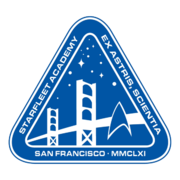Training Tutorial 6
| Cadet Orientation |
|---|
|
Tutorial 6: Military time, stardates, and how to address officersMILITARY TIMEOur group uses military time. It's a simple concept, but one that can take a little getting used to. Here's a quick example: 6:23am is written 0623 hours. For AM times, just add a “0” at the beginning. Instead of the clock resetting at 1pm, it continues to count up. 1pm becomes 1300, 2pm becomes 1400, and so on. An easy way to calculate this is to take any PM time and add 12 to the number. So, 6pm would be 6+12=1800 hours. At midnight, the clock starts over at Zero-hour: 0000 hours. STARDATESThe Star Trek universe uses a special dating system, due to the fact that everyone is moving around the galaxy at different times of the night and day. Our calendar is based on the Earth moving around the sun, but not everyone in Starfleet comes from Earth. So we use a system called "stardates." On the show, stardates were usually selected arbitrarily as a series "start value" and an "end value," so they didn't really mean anything. For our purposes, though, we need a way to keep track of everything that's happening In Character. You will be glad to hear that the In Character Stardate system is very simple. The format of our stardates is as follows: yyyymm.dd Where:
Meaning...:
When you add all these parts together, you have a stardate. Let's try one: June 15th, 2004 would become 238106.15. And the time, if it's 6:30 p.m.: 238106.15 – 1830h. To make it easy for you, today's stardate – 240104.11 – can always be found on the main page of the wiki: https://wiki.starbase118.net/wiki/ FORMS OF ADDRESS AND RANKSThe appropriate formal forms of address are as follows: At all times, use of an officer's rank combined with their last or only name is appropriate, as is their rank alone. For example:
It's fine to abbreviate ranks in our narrative, and it often makes things easier to read. For example, you might want to write "Lt. (JG) Bloggs", instead of "Lieutenant Junior Grade Joe Bloggs". You can see below for a list of ranks and their common abbreviations. The exception to this rule is when we're writing dialogue. We're transcribing character speech, so abbreviations should not be used. "FltAdml. Wolf" would be "Admiral Wolf" when spoken. When speaking to an officer of lower rank, you can use their rank combined with their last or only name, OR their last name alone, OR their rank alone, OR "mister" (yes, you can call a female officer "mister"). For example:
When speaking to a doctor, you can address them by their rank, or call them "Doctor," followed by their last or only name. For example:
StarFleet officers generally only call others by their first names while off duty, or when they're alone together and regulations aren't important. Be careful if you're speaking to an officer of higher rank, at any time! RANKSThere are many ranks one can ascend through in our group. Here's a list of them, with their abbreviations:
More detailed information about ranks, including Marine Corps ranks and their Starfleet equivalents, see the Starfleet Rank Index. PROMOTIONSOnce you have completed training and are posted to a ship, you are automatically promoted to the rank of Ensign. At the discretion of your commanding officer, you can rise in rank to Lieutenant Commander. To become a Commander or Captain, you must take both a written and a practical exam, which is administered by a friendly member of the community staff. You must also receive a recommendation that you are prepared for promotion. All ranks above Lieutenant Commander are presented at the discretion of the Captains and Executive Councils. For more information on promotion criteria, check out the Promotions area. SEE ALSO
|
| Starfleet Academy |
|---|
